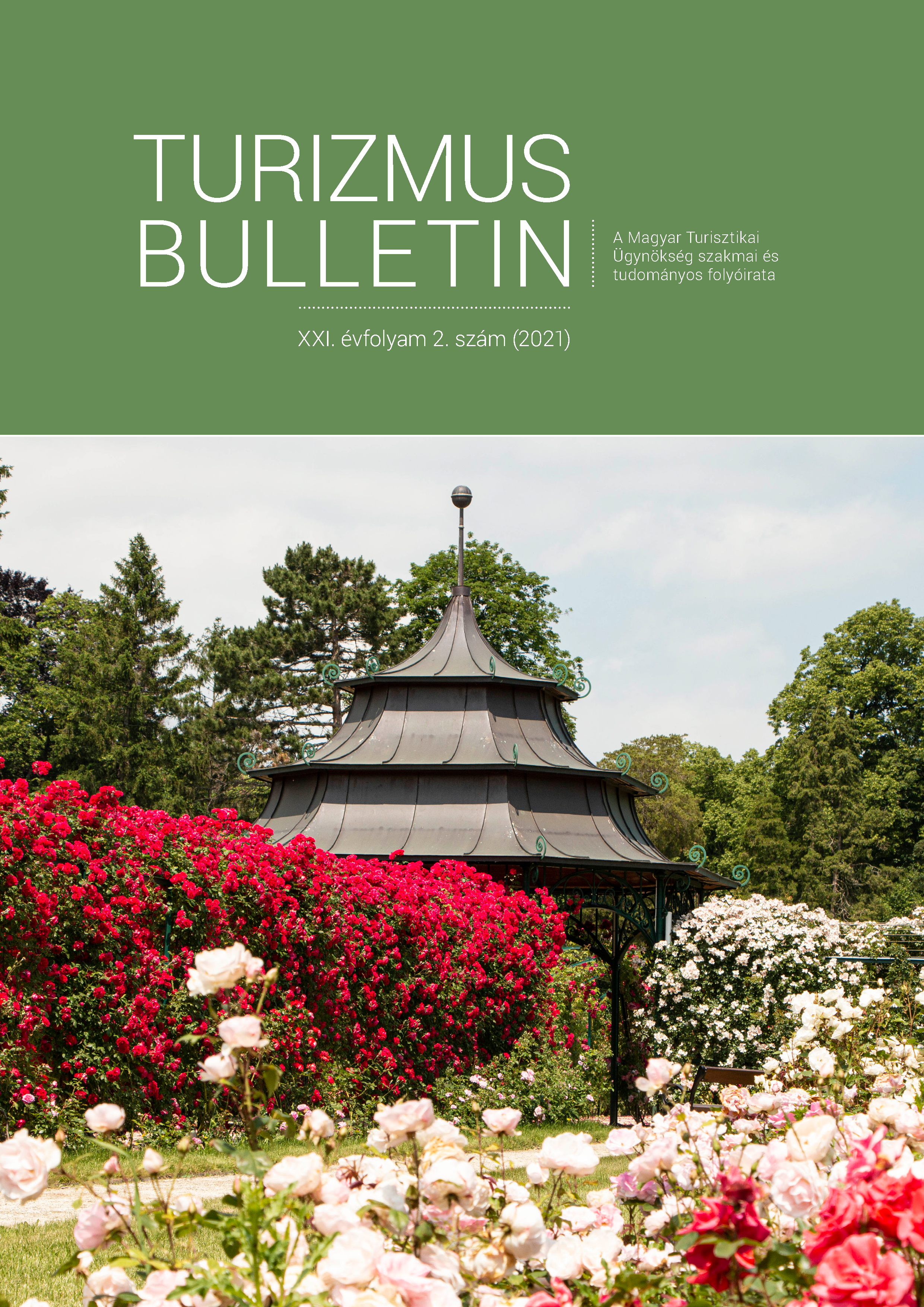Okos turizmus és okos rendezvények vizsgálata a Székesfehérvári Királyi Napok tükrében
DOI:
https://doi.org/10.14267/TURBULL.2021v21n2.4Kulcsszavak:
okos turizmus, okos rendezvény, Királyi Napok, SzékesfehérvárAbsztrakt
A digitalizáció hatása a turisztikai iparágra elvitathatlan mind a keresleti, mind a kínálati oldalt tekintve. Jellemzően a szolgáltatások foglalása, az attrakciók interpretációja kerül az online és digitális megoldások középpontjába, ugyanakkor a rendezvények esetében mindezen megoldások éppúgy szerepet kaphatnak. Az is látható, hogy a nagyvárosok életében népszerűek az okos turisztikai applikációk, de vajon mi a helyzet a kisebb hazai városokkal, a vidéki desztinációkkal? Mindezen témák vizsgálata áll jelen cikkünk középpontjában, az alábbi kutatási kérdésben összegezve: Mit jelenthet az okos turizmus Székesfehérvár esetében, és hogyan jellemezhető az okos rendezvény iránti kereslet a Királyi Napok tekintetében? A kérdések vizsgálatához egyrészt 13 szolgáltatóval készítettünk kvalitatív szakértői mélyinterjút, másrészt keresleti oldali kutatást végeztünk a helyi Turisztikai Desztináció Menedzsment Szervezet (TDMSZ) segítségével, mely során kérdőíves megkérdezésünkre 414 értékelhető választ kaptunk a 2019. évi Királyi Napok látogatóinak köréből.
Hivatkozások
ALT, R. – ZIMMERMAN, H. (2015): Electronic Markets on ecosystems and tourism. Electronic Markets. 25(3). pp. 169–174. https://doi.org/10.1007/s12525-015-0197-7
ARENAS, A. E. – GOH, J. M. – URUEÑA LÓPEZ, A. (2019): How does IT affect design centricity approaches: Evidence from Spain’s smart tourism ecosystem. International Journal of Information Management. 45. pp. 149–162. https://doi.org/10.1016/j.ijinfomgt.2018.10.015
BAL, C. – FLECK, N. (2016): Connected Stadium: A Pillar for Football Clubs’ Marketing Development? In: Plewa, C. – Conduit, J. (eds): Making a Difference Through Marketing. Springer, Singapore. pp. 43–58. https://doi.org/10.1007/978-981-10-0464-3_4
BOES, K. – BUHALIS, D. – INVERSINI, A. (2015): Conceptualizing Smart Tourism Destination Dimensions. In: Tussyadiah, I. – Inversini, A. (eds): Information and Communication Technologies in Tourism 2015. Springer, Cham. pp. 391–403. https://doi.org/10.1007/978-3-319-14343-9_29
BOROS K. (2019): Konferenciaturizmus. In: Irimiás A. – Jászberényi M. – Michalkó G. (szerk.): A turisztikai termékek innovatív fejlesztése. Akadémiai Kiadó, Budapest. pp. 50–61. https://doi.org/10.1556/9789634544081
BUHALIS, D. – AMARANGGANA, A. (2014): Smart Tourism Destinations. In: Xiang, Z. – Tussyadiah, I. (eds): Information and Communication Technologies in Tourism 2014. Springer, Heidelberg. pp. 553–564. https://doi.org/10.1007/978-3-319-03973-2_40
BUHALIS, D. – AMARANGGANA, A. (2015): Smart Tourism Destinations Enhancing Tourism Experience Through Personalisation of Services. In: Tussyadiah, I. – Inversini, A. (eds): Information and Communication Technologies in Tourism 2015. Springer, Heidelberg. pp. 377–389. https://doi.org/10.1007/978-3-319-14343-9_28
DEL VECCHIO, P. – MELE, G. – NDOU, V. – SECUNDO, G. (2018): Creating value from Social Big Data: Implications for Smart Tourism Destinations. Information Processing & Management. 54(5). pp. 847–860. https://doi.org/10.1016/j.ipm.2017.10.006
GANTI, R. K. – YE, F. – LEI, H. (2011): Mobile crowdsensing: current state and future challenges. IEEE Communications Magazine. 49(11). pp. 32–39. https://doi.org/10.1109/mcom.2011.6069707
GRETZEL, U. – SIGALA, M. – XIANG, Z. – KOO, C. (2015): Smart tourism: foundations and developments. Electronic Markets. 25(3). pp. 179– 188. https://doi.org/10.1007/s12525-015-0196-8
GRETZEL, U. – ZHONG, L. – KOO, C. (2016): Application of smart tourism to cities. International Journal of Tourism Cities. 2(2). pp. 216–233. https://doi.org/10.1108/IJTC-04-2016-0007
HAPP É. – IVANCSÓNÉ HORVÁTH ZS. – KUPI M. (2020): Digitális eszközök és módszerek használatának marketingszempontú feltáró elemzése a magyar turisták körében. Turizmus Bulletin. 20(2). pp. 4–13. DOI: 10.14267/turbull.2020v20n2.1
HÖJER, M. – WANGEL, J. (2015): Smart Sustainable Cities: Definition and Challenges. In: Hilty, L. – Aebischer, B. (eds): ICT Innovations for Sustainability. Advances in Intelligent Systems and Computing. 310. Springer, Cham. pp. 333–349. https://doi.org/10.1007/978-3-319-09228-7_20
KOVÁCS L. (2020): Kozmetikai márkák és divatmárkák – márkaasszociációs vizsgálatok eredményei. In: Kovács L. (ed): Határterületek 2019. Savaria University Press, Szombathely. pp. 105–118.
LEE, J.-S. – LEE, C.-K. – YOON, Y. (2009): Investigating differences in antecedents to value between first-time and repeat festival-goers. Journal of Travel & Tourism Marketing. 26(7). pp. 688–702. https://doi.org/10.1080/10548400903284511
LOPEZ DE ÁVILA, A. (2015): Smart destinations: XXI century tourism. ENTER2015 Conference on Information and Communication Technologies in Tourism, Lugano, Switzerland.
PAPP-VÁRY Á. (2014): Márkázott szórakoztatás. A termékmegjelenítés nemzetközi és hazai alkalmazása. Akadémiai Kiadó, Budapest. https://doi.org/10.1556/9789630597913
PARK, J. H. – LEE, C. – YOO, C. – NAM, Y. (2016): An analysis of the utilization of Facebook by local Korean governments for tourism development and the network of smart tourism ecosystem. International Journal of Information Management. 36(6). pp. 1320–1327. https://doi.org/10.1016/j.ijinfomgt.2016.05.027
SMITH, M. – MacLEOD, N. – ROBERTSON, M. H. (2010): Key Concepts in Tourist Studies. Sage, London. http://dx.doi.org/10.4135/9781446251027
SZMIGIN, I. – BENGRY-HOWELL, A. – MOREY, Y. – GRIFFIN, C. – RILEY, S. (2017): Socio-spatial authenticity at co-created music festivals. Annals of Tourism Research. 63. pp. 1–11. https://doi.org/10.1016/j.annals.2016.12.007
TARI A. (2017): Bátor generációk – Szorongok tehát vagyok. Tericum Kiadó, Budapest.
TIAN, B. – YAO, Q. – GU, Y. – WANG, K. – LI, Y. (2011): Video processing techniques for traffic flow monitoring: A survey. Proceedings of the 14th International IEEE Conference on Intelligent Transportation Systems (ITSC), Washington, DC. pp. 1103–1108. https://doi.org/10.1109/ITSC.2011.6083125
TORRES, E. N. – LUGOSI, P. – ORLOWSKI, M. – RONZONI, G. (2018): Consumer-led experience customization: A socio-spatial approach. Journal of Service Management. 29(2). pp. 206– 229. https://doi.org/10.1108/JOSM-06-2017-0135
XIA, W. – XIANG, (R.) L.– FENG, Z. – JINHE, Z. (2016): How smart is your tourist attraction?: Measuring tourist preferences of smart tourism attractions via a FCEM-AHP and IPA approach. Tourism Management. 54. pp. 309–320. https://doi.org/10.1016/j.tourman.2015.12.003
XIANG, Z. – FESENMAIER, D. R. (2017): Big data analytics, tourism design and smart tourism. In: Xiang, Z. –Fesenmaier, D. R. (eds.): Analytics in Smart Tourism Design, Tourism on the Verge. Springer International Publishing Switzerland. pp. 299–307. https://doi.org/10.1007/978-3-319-44263-1_17
ZHANG, L. (2012): Smart tourism: The coming age of customization and intelligent public services. Journal of Tourism Tribune. 27(2). pp. 3–5.
Internetes források
ALBA INNOVÁR (2020): https://albainnovar.hu/, Letöltve: 2020. augusztus 18.
KIRÁLYOK VÁROSA (2020): Teendők. https://kiralyokvarosa.eu/desktop/page.php?p=teendok&lang=hun, Letöltve: 2020. augusztus 19.
KSH (2108): TOP30 település a kereskedelmi szálláshelyek vendégéjszakái alapján. https://www.ksh.hu/interaktiv/kersza/szallashelyek.html?utm_source=kshhu&utm_medium=banner&utm_campaign=home, Letöltve: 2020. november 15.
YOO, T. (2012): Korea leading global smart revolution. Korea Times. http://www.koreatimes.co.kr/www/tech/2021/03/133_123643.html, Letöltve: 2021. május 28.

